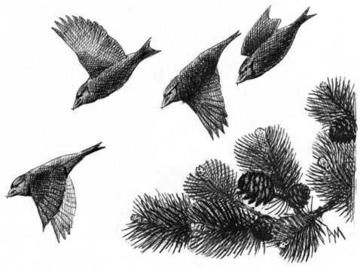
Crossbill © Andrew Mart
Depending on a single food source with crops that vary sporadically from one year to the next, Crossbills undertake some large post-breeding movements as they try to find another area with enough conifer seeds. These movements occur in summer, usually from late June, as the new year’s production of cones is forming. There are occasional massive eruptions from their continental breeding areas, when Crossbills may be seen in large numbers in new places. If the birds find sufficient food to sustain them for a few months, they often then breed in the new area, but are likely to quit for a different site in the following year. The numbers present may vary by a factor of ten from one year to another, the years of high population coming after an irruption when extra birds have stayed in the area. The largest influxes to the county in recent years were in the summer of 1990 and 1997, the observation of birds showing breeding intent in Macclesfield Forest in 1998 following the latter irruption.
The Atlas map shows birds sparsely distributed in winter, in only eleven tetrads, but broadly in four general areas of coniferous or mixed woodland: Delamere and Macclesfield Forests, Alderley Edge, and the southern end of the Sandstone Ridge. Others were found at Doddington (SJ74D), Daresbury Firs (SJ58R) and Frankby cemetery (SJ28N). Crossbills were reported from just three tetrads during 2004/ 05, six in 2005/ 06 and five in 2006/ 07. Most were in groups of six to eight, with two larger flocks in the Delamere area of 12 and 17 birds.
A century ago, Coward (1910) wrote ‘At irregular intervals flocks of Crossbills have occurred, chiefly in the winter, in woodlands in various parts of the county’. Larches were noted as the main attraction, before the mass planting of pines and spruces in the early 20th century. Boyd (1946) noted an influx into ‘the forest country of Cheshire’ in July 1935 and noted a flock among the Scots pines in Delamere Forest in March 1943, commenting that ‘we have seen little of Crossbills in Cheshire for some years’. Bell (1962) concurred with Coward’s general assessment of their status, and since then, Cheshire and Wirral Bird Reports contain few relatively records in the winter period. Large numbers were in Macclesfield Forest in 1993/ 94, with 59 birds on 15 January 1994, but none at all reported there in the following winter. They were ‘very obvious’ in Delamere Forest in 1997/ 98, but the maximum count was only 14, and the only other winter with substantial numbers was 2002/ 03, with up to 85 in Macclesfield Forest and 16 in Lyme Park (SJ98R).
The three years of this Atlas survey were ‘normal’ years for Crossbills in Cheshire and Wirral, uncomplicated by irruptions or subsequent extra breeding birds.
Sponsored by Michael S. Twist

